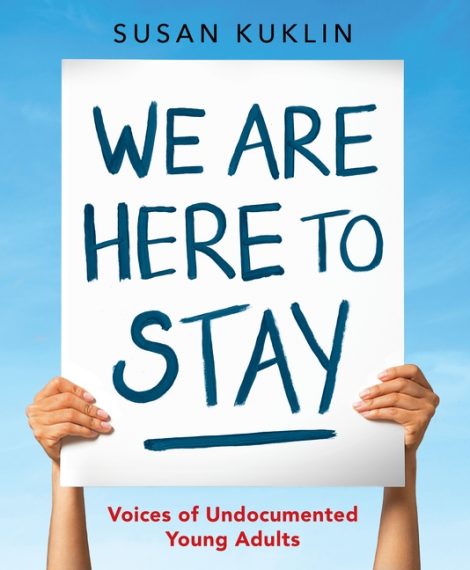
WE ARE HERE TO STAY
Voices of Undocumented Young Adults
The Stonewall Honor–winning author of Beyond Magenta shares the intimate, eye-opening stories of nine undocumented young adults living in America.
“Maybe next time they hear someone railing about how terrible immigrants are, they’ll think about me. I’m a real person.”
Meet nine courageous young adults who have lived in the United States with a secret for much of their lives: they are not U.S. citizens. They came from Colombia, Mexico, Ghana, Independent Samoa, and Korea. They came seeking education, fleeing violence, and escaping poverty. All have heartbreaking and hopeful stories about leaving their homelands and starting a new life in America.
The Stonewall Honor–winning author of Beyond Magenta shares the intimate, eye-opening stories of nine undocumented young adults living in America.
“Maybe next time they hear someone railing about how terrible immigrants are, they’ll think about me. I’m a real person.”
Meet nine courageous young adults who have lived in the United States with a secret for much of their lives: they are not U.S. citizens. They came from Colombia, Mexico, Ghana, Independent Samoa, and Korea. They came seeking education, fleeing violence, and escaping poverty. All have heartbreaking and hopeful stories about leaving their homelands and starting a new life in America. And all are weary of living in the shadows. We Are Here to Stay is a very different book than it was intended to be when originally slated for a 2017 release, illustrated with Susan Kuklin’s gorgeous full-color portraits. Since the last presidential election and the repeal of DACA, it is no longer safe for these young adults to be identified in photographs or by name. Their photographs have been replaced with empty frames, and their names are represented by first initials. We are honored to publish these enlightening, honest, and brave accounts that encourage open, thoughtful conversation about the complexities of immigration — and the uncertain future of immigrants in America.
- Candlewick Press
- Hardcover
- January 2019
- 192 Pages
- 9780763678845
About Susan Kuklin
 Susan Kuklin is the award-winning author and photographer of more than thirty books for children and young adults that address social issues and culture, including No Choirboy: Murder, Violence, and Teenagers on Death Row and Beyond Magenta: Transgender Teens Speak Out, which was named a Stonewall Honor Book. Her photographs have appeared in the Museum of the City of New York, documentary films, Time magazine, Newsweek, and the New York Times. Susan Kuklin lives in New York City.
Susan Kuklin is the award-winning author and photographer of more than thirty books for children and young adults that address social issues and culture, including No Choirboy: Murder, Violence, and Teenagers on Death Row and Beyond Magenta: Transgender Teens Speak Out, which was named a Stonewall Honor Book. Her photographs have appeared in the Museum of the City of New York, documentary films, Time magazine, Newsweek, and the New York Times. Susan Kuklin lives in New York City.
Praise
“We Are Here to Stay transcends politics and finds the common bonds of mankind.” —Shelf Awareness for Readers
“Readers will see how immigration organizations are structured and, prior to the ’90s, how open U.S. borders were. In their accounts, these teens discuss how they are processing DACA’s uncertainty and how they identify with being American (or not). A time line on immigration policies and laws and helpful chapter notes are appended. A thought-provoking read on immigration in America.”—Booklist
“Kuklin walked two tightropes in writing this book, doing so with competence and skill. Her first tour de force was to succeed in writing about people, not politics, even though the latter plays a consequential, even a central, role in the lives of those she writes about, in the form of immigration policies. Kuklin’s mastery is also manifest in her ability to engender empathy and compassion without writing a tear-jerker; the painful experiences, often narrated in a raw and unembellished manner, while inspiring, are more conducive to a productive conversation on the complicated issues of immigration. A must-read.”—Kirkus Reviews
“[The] author’s note and the annotated endnotes are essential to understand why there are empty frames where photos would typically appear and to consider the more difficult aspects of DACA that will affect the fates of the book’s contributors. For those who understand Kuklin and her interviewees’ intent, the visual redactions are haunting, and the subjects’ cautious but pervasive optimism is a troubling counterpoint to readers’ knowledge that the American welcome mat has subsequently been pulled out from under their feet.”—Bulletin of the Center for Children’s Books
“These empty pages are haunting, emphasizing the fear that the children live with, even as their stories address the importance of bringing their experiences out of hiding…We Are Here to Stay is an important book for anyone concerned about the issues surrounding undocumented immigrants.”—ForeWord Reviews
Discussion Questions
1. Consider the book’s title and subtitle. In what ways do they reflect the spirit of the interviews?
2. Talk about why you think the author chose to write in the first person rather than the third.
3. Describe the differences between the book’s two parts, “Coming to America” and “Twists and Turns.”
4. In the note to readers at the beginning of the book, the author writes that some of the young people she interviewed “described themselves as living in the shadows” (page viii). Find examples of this in the text. What different things do they mean by “the shadows”? How did having to keep secrets and avoid legal authorities affect the young people and their parents? As a metaphor, what feelings does the phrase “in the shadows” evoke?
5. Discuss the different reasons that the young people who were interviewed and their families came to the United States. Compare the ways they initially entered the country, such as on a visa or by hiring coyotes. How did the way they arrived affect them, their families, and their experiences in the United States?
6. Education is a central value for many of those interviewed. J—– from Ghana says, “I would do anything to get back to school” (page 105), while G—– from Mexico believes, “Good grades are a must! If I don’t do well, who knows what can happen, right?” (page 140). Why do they care so much about education? Why do their parents value it so highly? What kinds of problems did they face concerning college tuition because they were undocumented?
7. The young people in the book faced many barriers to success. Describe some of the barriers and examples of how they overcame them. Which barriers are similar for documented immigrants? Which are specific to being undocumented?
8. “If you don’t have papers, I feel that you should be more ambitious than anybody else,” says D—–, referring to being undocumented (page 13). Why does he think that? In what ways is he ambitious? Find other examples of those profiled who have a similar outlook. Do you agree or disagree with D—– about this? Why?
9. In the view of D—–’s sister Y—–, “The more blessings you have, the more you have to give back” (pages 15–16). What kind of blessings is she referring to? Discuss her statement in terms of the young people in this book and in more general terms. How do different young people in the book give back, and who are they giving back to?
10. Some of the siblings portrayed have similar experiences and feelings, while others do not. Take note of both kinds of siblings. What are some ways the siblings in this book help each other out? How do they also cause each other problems? Why do you think their experiences vary so much?
11. J—–, from Ghana, is the only person from the book to live in the United States without a parent. What else makes his story different? Why did his parents send him to the United States? Describe what happened to him in New York and why he didn’t know what to do about it. How was his problem solved? What did he consider his lucky breaks? What people have become like family to him?
12. Compare parents of the undocumented young people in the book. Describe ways that some parents supported their children, financially, emotionally, and otherwise. Did the culture of the parents’ birth country clash with their Americanized children? What, if any, conflicts arose as the children became more Americanized? How did the young people recognize and honor their parents’ sacrifice?
13. What different kinds of experiences did the interviewees’ parents have in their new lives? Which ones found career or financial success in the United States? Which ones worked at less desirable jobs than they might have had in their country of origin? Give examples of barriers that parents faced and how they coped with them. In what ways was the transition for the kids easier than for the parents?
14. Almost everyone who was interviewed encountered kindness from individuals in the United States. Give some specific examples of what people did for them and how it helped. Discuss what motivated this kind of behavior. What do you think your response would be to a newly arrived immigrant? How could you be helpful? Would their status as documented or undocumented influence your response?
15. Many of the young people also got help from organizations. Describe some of the organizations and what they did that was helpful. Which young people started helping others like themselves, and how? What do you think motivated them?
16. The children and teens new to the United States also encountered teasing and bullying. Describe some of those encounters and how they felt to the interviewees. What motivates kids to bully others? In what way are immigrants especially vulnerable to bullying?
17. Y—– refers to people “railing about how terrible immigrants are” (page 22). Find other references in the book to prejudice against immigrants. What instances of this do you know from your own experience? Why is there so much animosity toward immigrants, both now and in the past? Read over the time line of immigration laws (pages 161–164) and identify specific groups targeted negatively by the laws as well as those who benefited from them.
18. Respond to the photo-essay by describing the content and discussing the feelings the photographs evoke. What do you learn from the photos that is different from what you learned in the narrative? How do the photographs complement the text?
19. Discuss the book’s initial paragraph about omitting names and images (on the page before the table of contents). Explain what DACA is, how it was created, and why it was repealed. How did DACA affect the young people interviewed in the book? What was the relationship between DACA and being able to work? How did DACA vary by state? Why do you think the Trump administration wanted to end DACA?
20. Some novels portray the lives and challenges of undocumented immigrant children and teens. What are the differences between how fiction and nonfiction explore this topic? What can a nonfiction book offer that a novel can’t? Discuss what’s valuable about the book’s nonfiction features, such as the time line, chapter and author notes, and resources section.
